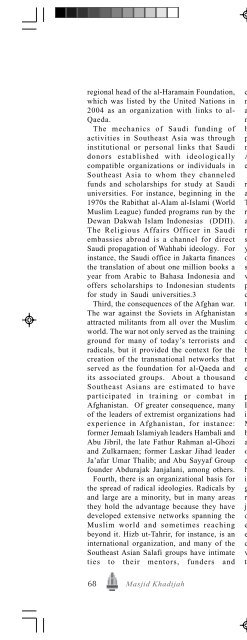inab3 cover front.psd - Khadijah Mosque
inab3 cover front.psd - Khadijah Mosque
inab3 cover front.psd - Khadijah Mosque
Create successful ePaper yourself
Turn your PDF publications into a flip-book with our unique Google optimized e-Paper software.
egional head of the al-Haramain Foundation,<br />
which was listed by the United Nations in<br />
2004 as an organization with links to al-<br />
Qaeda.<br />
The mechanics of Saudi funding of<br />
activities in Southeast Asia was through<br />
institutional or personal links that Saudi<br />
donors established with ideologically<br />
compatible organizations or individuals in<br />
Southeast Asia to whom they channeled<br />
funds and scholarships for study at Saudi<br />
universities. For instance, beginning in the<br />
1970s the Rabithat al-Alam al-Islami (World<br />
Muslim League) funded programs run by the<br />
Dewan Dakwah Islam Indonesias (DDII).<br />
The Religious Affairs Officer in Saudi<br />
embassies abroad is a channel for direct<br />
Saudi propagation of Wahhabi ideology. For<br />
instance, the Saudi office in Jakarta finances<br />
the translation of about one million books a<br />
year from Arabic to Bahasa Indonesia and<br />
offers scholarships to Indonesian students<br />
for study in Saudi universities.3<br />
Third, the consequences of the Afghan war.<br />
The war against the Soviets in Afghanistan<br />
attracted militants from all over the Muslim<br />
world. The war not only served as the training<br />
ground for many of today’s terrorists and<br />
radicals, but it provided the context for the<br />
creation of the transnational networks that<br />
served as the foundation for al-Qaeda and<br />
its associated groups. About a thousand<br />
Southeast Asians are estimated to have<br />
participated in training or combat in<br />
Afghanistan. Of greater consequence, many<br />
of the leaders of extremist organizations had<br />
experience in Afghanistan, for instance:<br />
former Jemaah Islamiyah leaders Hambali and<br />
Abu Jibril, the late Fathur Rahman al-Ghozi<br />
and Zulkarnaen; former Laskar Jihad leader<br />
Ja’afar Umar Thalib; and Abu Sayyaf Group<br />
founder Abdurajak Janjalani, among others.<br />
Fourth, there is an organizational basis for<br />
the spread of radical ideologies. Radicals by<br />
and large are a minority, but in many areas<br />
they hold the advantage because they have<br />
developed extensive networks spanning the<br />
Muslim world and sometimes reaching<br />
beyond it. Hizb ut-Tahrir, for instance, is an<br />
international organization, and many of the<br />
Southeast Asian Salafi groups have intimate<br />
ties to their mentors, funders and<br />
counterparts in the Middle East. Liberal and<br />
moderate Muslims, although a majority in<br />
almost all countries, have not created similar<br />
networks, although efforts are now<br />
beginning to be made, by some of the people<br />
present in this room, to network together<br />
moderate Muslim organizations in Southeast<br />
Asian—an effort that perhaps could be<br />
expanded on a global scale.<br />
Fifth, another reason for the spread of<br />
radical Islamist groups is their aggressive<br />
and sophisticated recruitment techniques.<br />
The targets are separate potential pools of<br />
recruits, each requiring different methods<br />
and venues for recruitment. The key<br />
recruitment nodes are mosques and Islamic<br />
study circles; schools, universities, and<br />
youth organizations; health and welfare<br />
organizations, including charities; and other<br />
social clusters. Recruitment methodologies<br />
vary: in universities, for instance, the<br />
process involves Quranic study groups or<br />
circles where members gradually internalize<br />
the ideology of the group. This has been the<br />
specialty of the PKS in Indonesia. In<br />
economically and socially marginalized<br />
districts, recruits might be willing to join the<br />
extremist group as an avenue of escape from<br />
boredom or unemployment. Laskar Jihad<br />
recruited among the poorest and less<br />
educated segments of the population,<br />
especially the young rootless urban poor.<br />
Sixth, I should mention that violence itself<br />
plays a central role in recruitment.<br />
International jihadists have become involved<br />
in conflicts from Chechnya and Kashmir to<br />
Maluku and Poso, ostensibly to help<br />
beleaguered Muslims in these regions, but<br />
also to gain credibility among some sectors<br />
of the broader Muslim communities and<br />
especially among the young people that they<br />
hope to entice into joining. We see, for<br />
instance, that the playing of sometimes very<br />
graphic tapes of the armed jihad has a central<br />
role in recruitment events. But these local<br />
jihads also provide new members with a “rite<br />
of passage” which is the functional<br />
equivalent of the previous generation’s<br />
experience in Afghanistan Beyond that, it<br />
could be that from the jihadist standpoint,<br />
violence is its own justification. According<br />
to Zachary Abuza, the concept of purifying<br />
68 Masjid <strong>Khadijah</strong>
















